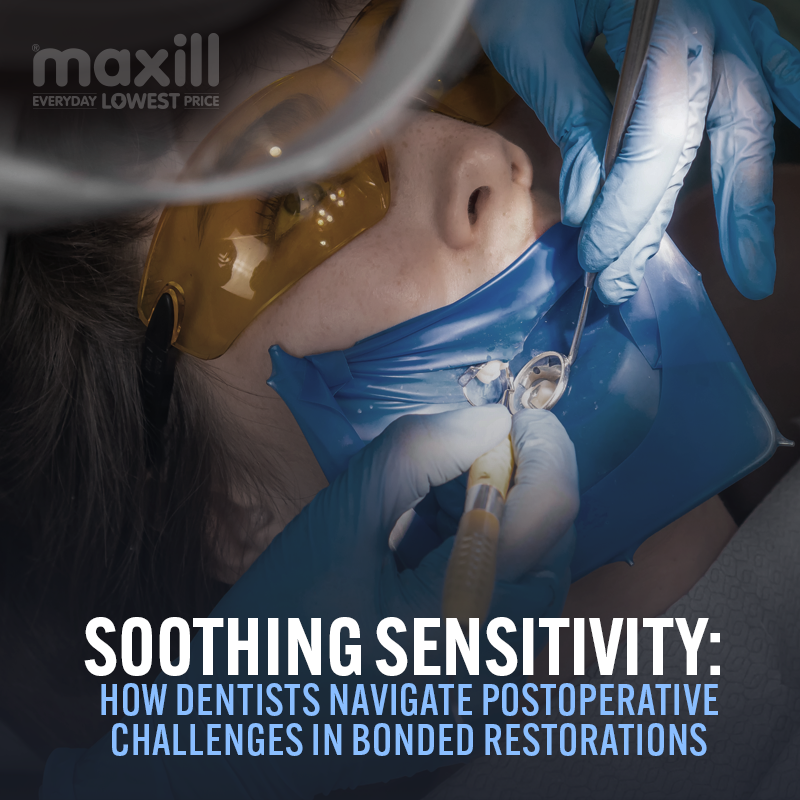Soothing Sensitivity: How Dentists Navigate Postoperative Challenges in Bonded Restorations

White fillings, otherwise known as composite resin restorations, have revolutionized modern dentistry, allowing dentists to provide patients with aesthetically pleasing and durable solutions for damaged or decayed teeth. However, postoperative sensitivity remains a significant concern for both clinicians and patients. Although postoperative sensitivity can naturally occur, let’s dive into three of the primary causes of postoperative sensitivity that dentists look for and provide evidence-based strategies that contribute to minimizing its occurrence when they place composite resin restorations.
Understanding the Causes of Postoperative Sensitivity
There are three main factors dentists consider when a patient presents with postoperative sensitivity:
Polymerization Shrinkage
During the curing process of a composite resin restoration, shrinkage occurs. This process, known as polymerization shrinkage, leads to contraction and stress on the adhesion to the dentin of the tooth. The C-Factor, which indicates the proportion of bonded to unbonded surfaces, significantly affects how composite resin polymerization behaves.
Notably, the traditional cavity preparations dentists use with parallel walls, initially tailored for amalgam or “silver fillings”, can pose challenges for dentists when applied to composite resin restorations. The uniform and straight walls of parallel designs have known to exacerbate issues related to shrinkage forces, high C-Factors, and difficulties in achieving optimal bond strength and marginal adaptation.
Microleakage
Microleakage refers to the small gaps or openings that can occur between a composite restoration and the tooth structure. These gaps are an additional concern to dentists because they provide pathways for fluids, like saliva, to seep into the tooth-restoration border. Inadequate sealing around the margins of the restoration, means these fluids can infiltrate the tiny spaces between the filling material and the tooth.
When saliva and other fluids penetrate these spaces, they can reach the dentinal tubules, which are microscopic channels within the tooth that lead directly to the nerve tissue. This infiltration can cause sensitivity or pain in the tooth.
Residual Stress
Built-up residual stress in the tooth after direct restorative material placement can contribute to postoperative sensitivity. Stress on the bond to dentin is a critical factor, emphasizing the importance of controlling shrinkage at the bond interface.
Dentists use various methods to alleviate residual stress and enhance the stability of the restorations they place. Applying practices such as incremental layering during material placement, involving the application of composite resin in small, sequential increments allowing the dentist to control curing between each layer, which they've noted can assist in reducing shrinkage forces at each step.
Moreover, exercising curing techniques that promote a gradual polymerization process, such as soft start curing modes, can also support dentists in minimizing the overall stress imparted to the tooth structure.
Strategies Used to Prevent Postoperative Sensitivity
Isolation and Stress-Free Bond Creation
Ensuring a stress-free bond is a crucial aspect of minimizing postoperative sensitivity in composite resin restorations. Dentists employ various techniques as part of their approach. This may involve ensuring proper isolation is maintained in addition to the careful application of etching solutions to dentin, adhering to manufacturer instructions throughout the process.
Adequate isolation can be difficult but is often achieved using rubber dams, parotid saliva control, or alternative isolation systems, creating a controlled environment for dentists while reducing the risk of contamination during the restoration process. Meticulous moisture control ensures a dry operating field to reduce the risk of any moisture intrusion that can compromise the bond.
During material application, a focus on layering techniques and strategic placement within the cavity helps clinicians manage shrinkage. Overall, these practices dentists are embracing contribute to their creation of a stable bond and can ultimately enhance the success of dental restorations and the comfort of patients.
Desensitizers
Utilizing desensitizers under the liner has been proven to significantly reduce postoperative sensitivity. Commonly employed desensitizing agents encompass substances such as glutaraldehyde/hydroxyethylmethacrylate, chlorhexidine, agents based on fluoride, and potassium oxalate.
An oxalate -based desensitizer placed under the liner has yielded promising results for dentists in reducing sensitivity after restorative work. The crystals created by the desensitizer prevent fluid movement in dentinal tubules without compromising the bond, providing an additional layer of protection against sensitivity.
Strategic placement of desensitizers can enhance the effectiveness of the restoration being placed by preventing fluid from accessing and triggering a nerve response.
Layering Techniques and Material Considerations
In modern dental practices, a technique gaining prominence involves layering of composite resin in horizontal increments, deviating from the traditional approach of bulk filling. This method, often accompanied by using flowable composite resins, allows dentists to achieve precise control over the application and curing process.
The emphasis here is not on specific steps but on the overall strategy dentists employ. The intention is to ensure thorough and effective curing, ultimately allowing clinicians to minimize the likelihood of postoperative sensitivity. Additionally, dental professionals prioritize the selection of materials known for their stress-reducing properties, contributing to the overall success of composite resin restoration procedures.
Reviewing Technique and Equipment
In the field of contemporary dentistry, practitioners acknowledge the importance of periodic reviews of their placement techniques. Ongoing continuing education courses allow dentists to evolve their skillset and master their overall methodologies utilized.
Dentists routinely assess the output and proximity of their curing lights, ensuring that these devices operate optimally for the desired outcomes. Caution is also taken place against over-etching and over-drying as part of this thoughtful approach, aiming for a delicate balance in the treatment process. Additionally, the commitment dentists have in maintaining equipment cleanliness and ensuring they sustain proper isolation, remains paramount in contributing to the consistency of successful outcomes in their restorative procedures.
Bite Adjustment and Post-Treatment Evaluation
Beyond the initial phases of a dental procedure, dental practitioners recognize the significance of post-treatment evaluation in ensuring optimal outcomes. In many cases postoperative sensitivity can often be associated with a high restoration, and relief can be achieved through an adjustment to the bite. This meticulous process involves evaluating the occlusal contact points and ensuring that the dental restoration aligns seamlessly with the patient's bite. Many cases of discomfort can be effectively addressed through this adjustment alone, alleviating the tenderness for the patient.
However, in the event postoperative sensitivity persists despite bite adjustments, dentists may delve into more comprehensive measures. This could involve the use of specialized tools such as a ‘Tooth Slooth®’ to identify potential gaps, or in rare cases the removal and replacement of the composite resin material. This dedicated approach by dentists, coupled with stress reduction protocols, underscores the commitment to resolving any lingering issues and safeguarding their patient's comfort post-dental restoration.
The Evolution of Techniques
Dental practitioners have continuously worked towards refining their techniques to effectively manage postoperative sensitivity over the years. Experienced clinicians, such as Dr. Richard Young, emphasize the significance of stress-free bonding techniques in their approach. Adhering to manufacturers' instructions for total etching, incorporating directed shrinkage techniques, and employing a controlled layering process for composite resin are pivotal aspects of Dr. Young's methodology, that many dentists exercise today.
In the late 1980s to 1990s, dentists explored innovative approached like direct shrinkage, utilizing low-viscosity, rapid self-curing hybrid composites. This technique, aiming at controlling shrinkage and postoperative sensitivity, involved injecting composite into the cavity preparation in a specific manner.
In restorative dentistry today, dentists have evolved with the introduction of the immediate dentin sealing and resin coating concept, building on these proven techniques. Many of todays practitioners have adopted these advanced approaches, involving the use of flowable composites judiciously, adjusting curing light intensity, and integrating stress reduction measures. These strategies collectively represent a modern and comprehensive approach to bonded restorations that many of today's dentists embrace. ¹
Patient Education Component
Patient education can also be an integral aspect of sensitivity management. Dentists play a crucial role in ensuring patients understand the various causes of sensitivity and providing comprehensive post-care guidance when applicable. It's important to note that tooth sensitivity isn't always postoperative; multiple factors can contribute. Patients experiencing chronic sensitivity may be advised to avoid extreme temperature stimuli, use desensitizing toothpaste regularly, and maintain gentle yet meticulous oral hygiene practices. Additionally, dietary adjustments may be suggested, such as limiting acidic foods.
In cases of persistent sensitivity, patients should promptly seek a follow-up with their dentist for a thorough evaluation and potential additional treatment options or recommendations. This approach empowers individuals to take charge of their oral health and well-being.
Concluding Thoughts…
In the ever-changing field of modern dentistry, composite resin restorations have transformed the landscape, offering both aesthetic appeal and durability. However, the persistent concern of postoperative sensitivity that dentists face necessitates a nuanced exploration of its causes and evidence-based strategies for mitigation. Dentists are carefully navigating the challenges posed by polymerization shrinkage, microleakage, and residual stress during composite resin restorations. These factors that dentists have encountered, intricately intertwine with their traditional practices and contemporary techniques, demanding a comprehensive understanding and strategic methodology.
By prioritizing isolation, stress-free bond creation, leveraging desensitizers, adopting layering techniques, and continually refining their approaches, dentists are navigating the evolution of restorative dentistry. Whether sensitivity stems from postoperative factors or other causes, patient education emerges as a collaborative component, empowering individuals to have open communication with their dental provider to comprehend sensitivity causes and follow any at-home care guidance, thereby cultivating a culture of informed oral health practices. This collective effort fosters a journey towards comfortable composite resin restorations and the reduction of post-operative sensitivity.
Resources
- [1]Lively, T. 2022, September 14. 5 Ways to Reduce Postoperative Sensitivity for Dental Patients. https://www.dentalproductsreport.com/view/5-ways-to-reduce-postoperative-sensitivity-for-dental-patients
- Prakash, M. et al. February 2023. How to Avoid Post-op Sensitivity in Adhesive Dentistry. Dimensions of Dental Hygiene. 21(2)42-45. https://dimensionsofdentalhygiene.com/article/how-avoid-post-sensitivity-adhesive-dentistry/#respond
- Davidovic, Lado & Radovic, Igor & Krunić, Jelena. (2014). Prevention of postoperative sensitivity in composite restorations. Stomatoloski glasnik Srbije. 61. 84-92. 10.2298/SGS1402084D.







